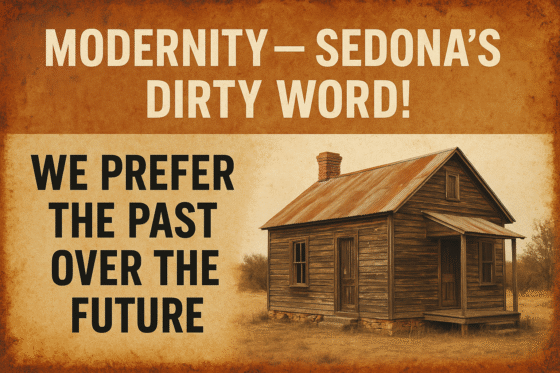By Bear Howard —
Sedona, Arizona, is a place defined as much by its people as by its crimson cliffs and cathedral-like spires of sandstone. The red rocks stand eternal, guardians of a desert landscape that has long enchanted artists, seekers, and wanderers.

Yet beneath the postcard beauty lies a community wrestling with its own reflection—a town where nostalgia for a simpler past has become a rallying cry, even as the pressures of the present grow stronger with each passing year.
For many residents, Sedona is not just a home but a refuge. They recall the days when the town was little more than a scattering of artists’ studios, family-owned cafés, and neighbors who all knew one another by name. Life moved slower then. Traffic was lighter. The word “development” was not a daily worry, nor was it an existential threat.
Today, the influx of visitors, the boom of short-term rentals, the rising cost of living, and the ceaseless march of commercial projects have stirred unease. For a sizable portion of Sedona’s population, the answer is not adaptation but retreat. Their adopted mantra: Modernity—Sedona’s dirty word!
One of the strongest expressions of this mindset lies in the near-sacred fixation on views. Many residents hold fast to the belief that nothing taller than two stories should ever rise in town, as if an invisible wall protects every sightline to the red rocks. That conviction, powerful and deeply felt, has become a tool to oppose almost any zoning change involving building height—and by extension, density.
The irony is that density, whether achieved through taller structures or closer ones, is the very means by which communities across the country create affordable housing and sustain modern life. Sedona’s protective posture preserves beauty but also limits options for younger families, workers, and future residents who might otherwise call the town home.
The longing for a town that “once was” speaks to a deep human desire for stability, belonging, and continuity. It is a wish to hold on to the Sedona of memory, where sandstone vistas were not shadowed by subdivisions and where the hum of cicadas drowned out the buzz of off-road vehicles.
For many, preserving the past is not simply nostalgia but survival—cultural, environmental, and spiritual. After all, if Sedona becomes just another stop on the interstate of modern America, what makes it unique?
And yet, time tells a different story. The Sedona of the 1960s was not the Sedona of the 1920s; the Sedona of ranchers and homesteaders was not the Sedona of petroglyph carvers. Every generation has seen newcomers, new ideas, and new economies. To freeze the town in a snapshot risks turning a living community into a museum—beautiful, but static.
Still, resistance has become a defining part of Sedona’s civic life. Zoning debates flare over building heights. Housing proposals face lawsuits and delays. Efforts to expand economic opportunity beyond tourism are often met with suspicion. Even basic infrastructure—road expansions, broadband upgrades, public transit—can be cast as threats to Sedona’s soul. The cry echoes again: We prefer the past over the future.
Yet the paradox remains: even holding still requires a measure of progress. Preserving open space demands planning, legal protections, and revenue. Managing housing demand requires deliberate strategies, not simply wishful thinking.
Protecting a “small town feel” in a place of global renown means balancing restraint with thoughtful growth. Without some measure of modern adaptation, the very character so fiercely guarded may erode under the weight of unmanaged change.
Sedona today stands at a crossroads—caught between the permanence of its red rocks and the impermanence of human memory. To some, modernity is the enemy. To others, it is the only way the town can survive its own popularity.
The story of Sedona is not unique; echoes of it can be heard in New England villages, Pacific Northwest hamlets, and mountain towns across the West. But nowhere is it written with such vivid color as against the backdrop of Arizona’s sandstone cathedrals.
In the end, perhaps Sedona’s challenge is not to reject modernity outright but to redefine it—to embrace a form of modernity that does not erase the past but honors it, weaving old values into new frameworks. For the red rocks will remain long after zoning disputes and housing battles fade away. The real question is whether the people of Sedona can find a way to remain, too—not as relics of the past, but as stewards of a living, evolving future.




